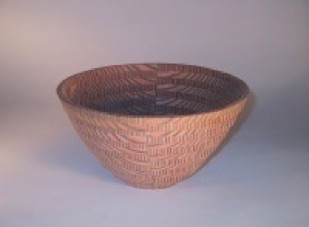Home Bio Process Gallery Featherwood Custom work CV Contact
The process I use to create bowls and vessels is often called stacked ring lamination. I use either a scroll saw or band saw for cutting, depending upon on the shape I’m after or the type wood used. I usually have a specific pattern in mind for the vessel and begin by gluing together selected lumber and/or veneer to create that desired pattern.
This can be a simple process with only a few laminations to very complex designs taking weeks of daily cutting and gluing, including fine mosaic patterns combining over 1,200 individual facets per square inch.
Whatever pattern I’ve designed gets worked into a slab form ¼” or more thick and a bit larger than the bowl’s intended diameter. Using a trammel or compass I draw the outer edge diameter on the slab and cut the line with the saw table set at an angle. Scribing another slightly smaller circle and cutting again yields a ring, and with repeated cutting, a sequence of decreasing sized layered rings results. If I’ve done the cutting well each ring will rest neatly atop the previous one, creating the bowl’s basic shape. For vases and closed shapes I make several starting slabs as identical as possible, and work every layer from detailed scale drawings with predetermined angles and diameters.
Shifting the rings in different orientations prior to gluing always yields interesting variations in how the bowl will appear. When I’ve decided which orientation to use I draw several registration lines down the entire outside surface so the rings can be positioned properly. Disassembling the layers I spread glue over the rim of the largest ring and set the next ring on it, paying close attention to registration. I repeat this gluing step through the remaining layers until the entire bowl is assembled. With the glued-up bowl set upside down, I carefully position a concrete block on the base layer to clamp it all together. I use polyurethane glue for all laminations and assembly.
Once dry, I rough sand the exterior on an inflatable drum sander and use various disc sanders on the interior. With a waste block glued to the base I chuck the bowl into a lathe which allows easier access to further refine and sand both surfaces. Final finishing is usually with micro-mesh abrasives, buffing rouge and polish.


